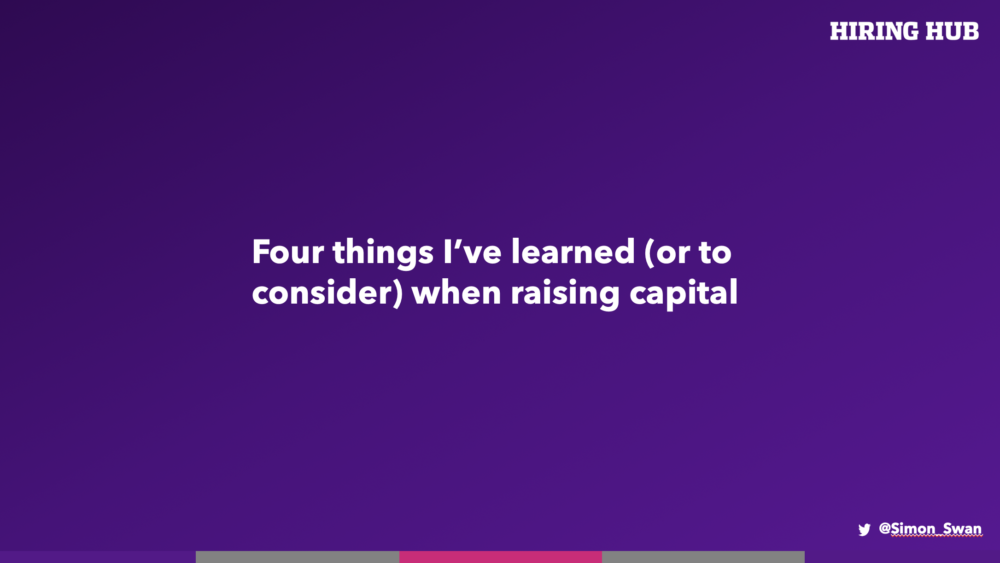
Presentation Notes: The Supper Club – Raising Finance to Scale Event
Simon was recently asked by The Supper Club to share lessons learned from raising finance to scale Hiring Hub, at an event in Manchester. It was to be a quick, 15-20-minute presentation followed by Q&A to an audience of predominantly business owners with companies at different stages of growth. The below formed Simon’s presentation notes for his talk, which we have decided to share as we felt the insight they offer could be useful for other early-stage founders seeking to raise capital.


- Freedom is lost
When I speak to people that have just started their own business, many cite “freedom” as a driving factor. Entrepreneurs all look different, but we generally share a handful of characteristics and traits. Most have a similar mindset.
Freedom to make their own decisions, to take control, to do it their way. When and how they want. To pay themselves what they want. To work when they wish, from where they want to. When they want to.
The dynamic changes when you raise money from a third-party investor. All of a sudden you are accountable to someone. Investors. Shareholders. A board of directors. You are expected to deliver a plan. You must grow shareholder value. This means growing your company, each day, each week, each month. And this adds to the pressure you ALREADY put on yourself to do better each day than you did yesterday.
Now, granted, those investors are backing you because they believe in you, but having them onboard will alter the feeling of freedom. As soon as you invite others into your business they will judge its performance, and your performance.
Whether they are angel investors spending their own money, or fund managers spending their investors’ money, they will only invest if they believe they will get a good return from their investment. They want to see their “asset” – your company – grow in value.
You are responsible for this. It is a constant weight that you carry, and at times it can sit heavily on one’s shoulders.
Now, you want to grow too. So you’re aligned. But you are much closer to your business day-to-day. And your industry. You know all the nuances. The challenges. The competitors. The threats on the horizon. The immediate fires you must put out, the opportunities to partner, to open up a new channel…
Investors see a monthly board pack. Management Accounts. Fancy graphs. But ultimately a spreadsheet with numbers on it. They expect you to hit those numbers. If you do, great. But when you don’t – few plans survive contact with the enemy – it can be hard.
And you certainly do not feel free. You feel responsible. Accountable. It is a dynamic that was not present in your business pre-investment, and it can take time to feel comfortable with it.
Takeaway #1:Only take on investment if you are prepared to give up a good degree of the very thing you originally yearned for when starting your business: Freedom.
- Spending the money
There’s loads of really good content online about crafting the perfect pitch deck; how to be concise and make every slide count. So I’ve decided not to touch on that. Instead, I wanted to talk very briefly on something I don’t read about as much… spending the money!
You will only raise capital if you have a very clear plan. That plan must show how, by using an investor’s money, you can scale your company from A to B, and thus increase its value from X to Y, and what that would mean to someone who’s invests at valuation “X” ONLY because she believes you can get to valuation “Y”, and has calculated her 2x, 5x, 10x return.
I talk to a lot of founders that want to raise money, and they broadly know why, but few have put together a detailed 12/24/36 month plan to show exactly how that money will be deployed to create value.
How much is for sales and marketing, for engineering, for operations… what impact will these investments have in the short-, mid-, long-term.
A simple financial model that an investor can get hold of and see when you’re investing, in what, and how it impacts cash and growth, is crucial so they can understand what’s driving the business – now and in the future – what assumptions you’ve made, what evidence you have in those assumptions, and how sensitive your numbers are to those assumptions. They need confidence that:
- Your plan is achievable
- You will have enough capital to execute it, plus some headroom if it goes wrong or it takes longer than you envisage
- In executing it, you have created value so their % stake is worth more than it was when they invested
If you cannot clearly articulate exactly why you need the money and how you’ll spend it. In both shorthand and in immense detail, then you will not be able to raise capital.
Prepare your plan diligently, then share it with someone independent that you trust. Let them tear it apart so you can rebuild it. Do this a few times until it’s watertight. It may feel like a waste of time – it isn’t. The process will see you questioning every cell on the spreadsheet, ensuring you can justify why the number sits within it and giving you a very clear and deep understanding of how, when, and why you’ll deploy the capital.
It’s a plan, so it will be wrong (they almost always are), but the process is important to undertake as the founder of a growth-minded company, and vital if you’re to demonstrate to an investor that you have thought of every scenario and have a clear strategy – or five – to fuel growth.
Takeaway #2: Be really clear why you need the money, what you’ll use it for, and where it will take you.
- Being a “CEO”
One of the big learnings for me, and this is still is in constant and fluid development, is how best to lead and manage a company – both upwards and downwards.
For context…. I did not set out to be a CEO. I just started a business because I saw an opportunity, and the engineer in me wanted to build something, while the free spirit in me wanted to go it alone. In part just to see if I could.
I am a founder. Despite what many think, I went to a shit school, got below average grades and didn’t go to university. The careers advisor told me “you’ll never be out of work if you get a trade…” she suggested I consider plumbing.
The idea of unblocking toilets did not appeal so I applied for an electrical and electronic apprenticeship at a diesel engine factory in Peterborough. I left as soon as I had completed it, and then spent most of my twenties chasing my passion: riding motorcycles for a living.
So I am not an executive. I was not groomed over many training courses and promotions to become a CEO. I had no idea, really, what the role meant when an investor looked at Sara and I and said: “which one of you is going to be the CEO?”
In fact, I was embarrassed to be “CEO” of such a small company. I didn’t think we needed one. It was a label. A grand title. When what we needed was a sales person. A marketer… But now I understand why he pushed us on it. And what the role of a CEO really is.
As soon as you take on investment, have a board structure, governance, reporting… it becomes clear why a CEO is necessary, but on day one it’s hard to understand what being one really means. It took me a few years to get my head around my role, and it’s still a work-in-progress.
As CEO of an investment-backed company you lead:
- Driving the company’s vision and repeating it ad nauseam
- Building the team, and management team
- Ensuring the company doesn’t run out of money
That means managing downwards: management team, operations, performance, recruitment, finance, etc – but we all do that anyway (and it’s probably a large part of what we enjoy about building our own businesses).
The big learning was managing upwards – Board and investors – and how much of my time this would take as we grew, matured, and as we took on more investment. I’ll come to that next, but before I do…
Takeaway #3: The CEO’s job is to align everyone around the vision/mission (and driving the subsequent strategies to achieve it), recruit great people, and make sure the company doesn’t run out of money.
- Communication
Managing a Board of Directors and multiple investors – both independent angels and institutional funds – means lots of people want a piece of you, lots of the time. Beyond the monthly management accounts and board packs, they want 121s, they want coffees, chats, a beer… they want to know beyond the KPIs and spreadsheets: how are you feeling? What’s happening? Why did we miss this number last month? Should we be doing this thing? Can we white label it? Should we? I’ve seen this new company, are they a competitor…?
At one point it got almost overwhelming. One investor would call me at 9pm every Friday, others would call at random times in the week, some would email, text, WhatsApp… Everyone wanted me. Seemingly all of the time. I was repeating myself over and over. I was spending so much time “managing upwards” I didn’t have a lot of time to run the business. It was even impacting family time. Significantly. As much of the comms would take place outside of core work time, in the evenings of over the weekend.
Now I consolidate comms into one weekly email. It’s structure I’ll share (the template is not mine, I found it online in a great blog on founder discipline by @collinmathilde, the founder of Frontapp, and it’s brilliant). It’s become a weekly ritual on a Friday afternoon and I actually find it useful to sit down and quietly analyse before succinctly summarising the week.
I ‘cc’ management so they understand how our actions as a team/company are interpreted by investors and the Board, driving greater visibility and accountability.
The structure is simple: Key weekly KPIs, and how they’re compounding monthly. Plus cash position. Then a bulleted summary of good things and not-so-good things, or challenges.
I am very candid – one thing investors really don’t like is surprises – so if I see a threat or challenge on the horizon I’ll share it, with a solution (if we have one) or I’ll ask for help if I think they could support us or add some value. If we have any big projects – a tender or fundraise as we did in Q1 – I’ll update on progress of these, too.
Over time this has reduced the volume of: “where is this up to…?” text messages and random calls. Everyone on the Board knows exactly where we’re up to, all the time. Or they have no excuse if they don’t! So when they do reach out they’re better informed, and therefore better positioned to add value.
Takeaway #4: Over communicate to the Board and investors, and be honest. (Copy in management too; it provides visibility, drives accountability, and stops you saying things twice.)
Want to find quality candidates quickly and fill professional jobs fast? Try Hiring Hub today. Hassle-free hiring.


